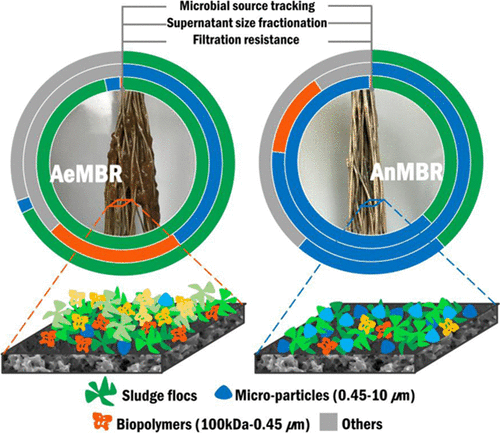当前位置:
X-MOL 学术
›
ACS Sustain. Chem. Eng.
›
论文详情
Our official English website, www.x-mol.net, welcomes your feedback! (Note: you will need to create a separate account there.)
Micro-particles—A Neglected but Critical Cause of Different Membrane Fouling between Aerobic and Anaerobic Membrane Bioreactors
ACS Sustainable Chemistry & Engineering ( IF 8.4 ) Pub Date : 2020-10-27 , DOI: 10.1021/acssuschemeng.0c06502 Yuanyuan Yao 1, 2, 3 , Zhongbo Zhou 1, 4 , David C. Stuckey 5, 6 , Fangang Meng 1, 2, 3
ACS Sustainable Chemistry & Engineering ( IF 8.4 ) Pub Date : 2020-10-27 , DOI: 10.1021/acssuschemeng.0c06502 Yuanyuan Yao 1, 2, 3 , Zhongbo Zhou 1, 4 , David C. Stuckey 5, 6 , Fangang Meng 1, 2, 3
Affiliation

|
Until recently, membrane fouling in anaerobic membrane bioreactors (AnMBRs) was generally understood based on and by extrapolating from well-studied aerobic membrane bioreactors (AeMBRs). Clearly, this will probably be unhelpful, as each contains different microbial ecology, particles/colloids, and soluble microbial products. In this paper, a comprehensive comparison was made between these two systems to understand their different sources of foulants and, hence, differences in fouling. Our results showed that worse fouling occurred in the AnMBR than in the AeMBR due to the different characteristics of bulk solutions. Filtration tests revealed that the bulk solution supernatant in the AnMBR contained more abundant micro-particles (0.45–10 μm, 69.4% of the total organics), exhibiting a much higher specific filtration resistance (1.56 × 1015 m–1/g TSS) and a unified modified fouling index value (4.56) than the AeMBR (36.4%, 2.17 × 1012 m–1/g TSS and 0.03, respectively). Based on Fourier transform infrared spectra combined with principal component analysis, the AnMBR foulants had functional groups similar to those of the micro-particles in the bulk solution, while the AeMBR foulants were more similar to extracellular polymeric substances of the bulk sludge. More interestingly, the microbial source tracking calculation utilizing 16S rRNA gene sequences showed that the micro-particles were an important source (22.6%) of the biocake microorganisms in the AnMBR but only contributed to 1.9% in the AeMBR. In contrast, the bulk sludge (67.7%) was determined to be a more dominant component of the biocake microorganisms in the AeMBR than in the AnMBR (38.7%). Our findings enable us to discriminate between the different sources of foulants in AnMBRs and AeMBRs and highlight the significance of micro-particles in anaerobic systems from abiotic and biotic aspects. It is clear in AnMBRs that a more sustainable form of treatment by reducing the micro-particles could be better for fouling control.
中文翻译:

微粒—好氧和厌氧膜生物反应器之间不同膜污染的被忽略但至关重要的原因
直到最近,厌氧膜生物反应器(AnMBR)中的膜污染通常是基于经过充分研究的好氧膜生物反应器(AeMBR)并从中推算得出的。显然,这可能无济于事,因为每种微生物都包含不同的微生物生态,颗粒/胶体和可溶性微生物产品。在本文中,对这两个系统进行了全面的比较,以了解它们的不同污垢来源,并由此了解污垢的差异。我们的结果表明,由于本体溶液的不同特性,与AeMBR相比,AnMBR的结垢情况更严重。过滤测试显示,AnMBR中的大体积溶液上清液包含更多的微粒(0.45–10μm,占总有机物的69.4%),具有更高的比过滤阻力(1.56×10)15 m –1 / g TSS)和比AeMBR(36.4%,2.17×10 12 m –1)统一的修正污垢指数值(4.56)/ g TSS和0.03)。基于傅立叶变换红外光谱结合主成分分析,AnMBR污垢具有与本体溶液中的微粒相似的官能团,而AeMBR污垢与本体污泥的细胞外聚合物更相似。更有趣的是,利用16S rRNA基因序列进行的微生物来源跟踪计算显示,微粒是AnMBR中生物饼微生物的重要来源(22.6%),但仅占AeMBR中的1.9%。相比之下,AeMBR中的整体污泥(67.7%)被确定为生物饼微生物的主要成分,而AnMBR中则为38.7%。我们的发现使我们能够区分AnMBR和AeMBR中不同的污垢来源,并从非生物和生物方面突出了厌氧系统中微粒的重要性。很明显,在AnMBR中,通过减少微粒来实现更可持续的处理形式可能更有利于结垢控制。
更新日期:2020-11-09
中文翻译:

微粒—好氧和厌氧膜生物反应器之间不同膜污染的被忽略但至关重要的原因
直到最近,厌氧膜生物反应器(AnMBR)中的膜污染通常是基于经过充分研究的好氧膜生物反应器(AeMBR)并从中推算得出的。显然,这可能无济于事,因为每种微生物都包含不同的微生物生态,颗粒/胶体和可溶性微生物产品。在本文中,对这两个系统进行了全面的比较,以了解它们的不同污垢来源,并由此了解污垢的差异。我们的结果表明,由于本体溶液的不同特性,与AeMBR相比,AnMBR的结垢情况更严重。过滤测试显示,AnMBR中的大体积溶液上清液包含更多的微粒(0.45–10μm,占总有机物的69.4%),具有更高的比过滤阻力(1.56×10)15 m –1 / g TSS)和比AeMBR(36.4%,2.17×10 12 m –1)统一的修正污垢指数值(4.56)/ g TSS和0.03)。基于傅立叶变换红外光谱结合主成分分析,AnMBR污垢具有与本体溶液中的微粒相似的官能团,而AeMBR污垢与本体污泥的细胞外聚合物更相似。更有趣的是,利用16S rRNA基因序列进行的微生物来源跟踪计算显示,微粒是AnMBR中生物饼微生物的重要来源(22.6%),但仅占AeMBR中的1.9%。相比之下,AeMBR中的整体污泥(67.7%)被确定为生物饼微生物的主要成分,而AnMBR中则为38.7%。我们的发现使我们能够区分AnMBR和AeMBR中不同的污垢来源,并从非生物和生物方面突出了厌氧系统中微粒的重要性。很明显,在AnMBR中,通过减少微粒来实现更可持续的处理形式可能更有利于结垢控制。



























 京公网安备 11010802027423号
京公网安备 11010802027423号